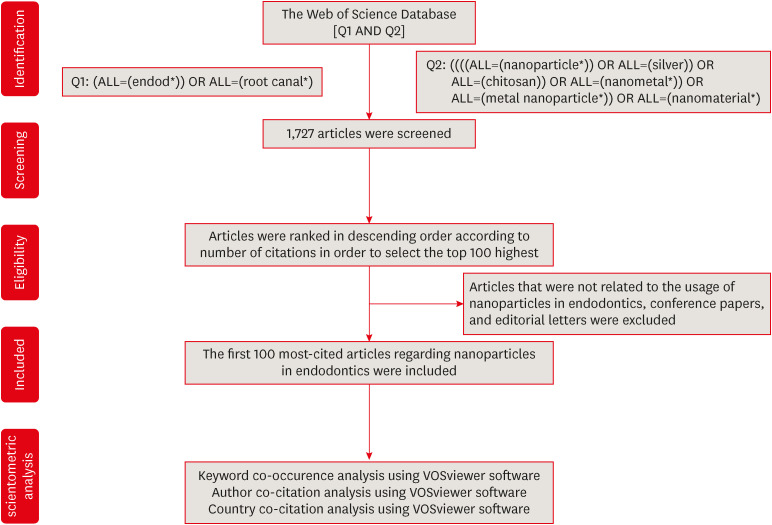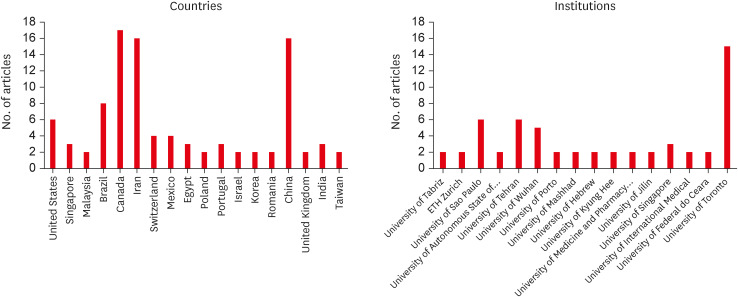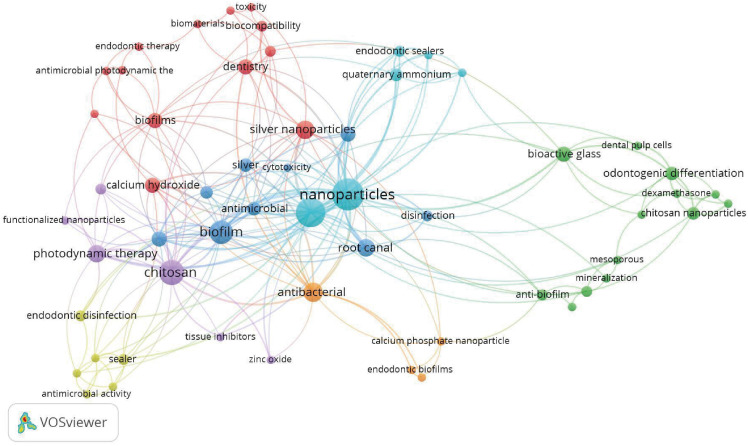1. European Commission. Commission recommendation of 18 October 2011 on the definition of nanomaterial (2011/696/EU). OJEU. 2011; 275:38–48.
2. Schmalz G, Hickel R, van Landuyt KL, Reichl FX. Nanoparticles in dentistry. Dent Mater. 2017; 33:1298–1314. PMID:
28951037.

3. Bayda S, Adeel M, Tuccinardi T, Cordani M, Rizzolio F. The history of nanoscience and nanotechnology: from chemical-physical applications to nanomedicine. Molecules. 2019; 25:112. PMID:
31892180.

4. Shrestha A, Kishen A. Antibacterial nanoparticles in endodontics: a review. J Endod. 2016; 42:1417–1426. PMID:
27520408.
5. Su M, Chen Y, Jia L, Zhang Z. Camptothecin-loaded and manganese dioxide-coated polydopamine nanomedicine used for magnetic resonance imaging diagnosis and chemo-photothermal therapy for lung cancer. Int J Nanomedicine. 2022; 17:6687–6705. PMID:
36597434.

6. Özdemir O, Kopac T. Recent progress on the applications of nanomaterials and nano-characterization techniques in endodontics: a review. Materials (Basel). 2022; 15:5109. PMID:
35897542.

7. Jandt KD, Watts DC. Nanotechnology in dentistry: present and future perspectives on dental nanomaterials. Dent Mater. 2020; 36:1365–1378. PMID:
32981749.

8. Wong J, Zou T, Lee AH, Zhang C. The potential translational applications of nanoparticles in endodontics. Int J Nanomedicine. 2021; 16:2087–2106. PMID:
33727815.

9. Fernandez CC, Sokolonski AR, Fonseca MS, Stanisic D, Araújo DB, Azevedo V, Portela RD, Tasic L. Applications of silver nanoparticles in dentistry: advances and technological innovation. Int J Mol Sci. 2021; 22:2485. PMID:
33801230.

10. Del Carpio-Perochena A, Kishen A, Felitti R, Bhagirath AY, Medapati MR, Lai C, Cunha RS. Antibacterial properties of chitosan nanoparticles and propolis associated with calcium hydroxide against single- and multispecies biofilms: an
in vitro and in situ study. J Endod. 2017; 43:1332–1336. PMID:
28578886.

11. Raura N, Garg A, Arora A, Roma M. Nanoparticle technology and its implications in endodontics: a review. Biomater Res. 2020; 24:21. PMID:
33292702.

12. Afkhami F, Ahmadi P, Chiniforush N, Sooratgar A. Effect of different activations of silver nanoparticle irrigants on the elimination of
Enterococcus faecalis
. Clin Oral Investig. 2021; 25:6893–6899.

13. Zakrzewski W, Dobrzyński M, Zawadzka-Knefel A, Lubojański A, Dobrzyński W, Janecki M, Kurek K, Szymonowicz M, Wiglusz RJ, Rybak Z. Nanomaterials application in endodontics. Materials (Basel). 2021; 14:5296. PMID:
34576522.

14. Fan W, Wu D, Ma T, Fan B. Ag-loaded mesoporous bioactive glasses against
Enterococcus faecalis biofilm in root canal of human teeth. Dent Mater J. 2015; 34:54–60. PMID:
25748459.

15. Upadya M, Shrestha A, Kishen A. Role of efflux pump inhibitors on the antibiofilm efficacy of calcium hydroxide, chitosan nanoparticles, and light-activated disinfection. J Endod. 2011; 37:1422–1426. PMID:
21924195.

16. Wu D, Fan W, Kishen A, Gutmann JL, Fan B. Evaluation of the antibacterial efficacy of silver nanoparticles against
Enterococcus faecalis biofilm. J Endod. 2014; 40:285–290. PMID:
24461420.

17. Valderrama P, Baca P, Solana C, Ferrer-Luque CM. Root canal disinfection articles with the highest relative citation ratios. A bibliometric analysis from 1990 to 2019. Antibiotics (Basel). 2021; 10:1412. PMID:
34827350.

18. Aksoy S, Aksoy U, Orhan K. An overview of the 35 years of research in the oral radiology: a bibliometric analysis. Oral Radiol. 2022; 38:183–191. PMID:
34143357.

19. Adnan S, Ullah R. Top-cited articles in regenerative endodontics: a bibliometric analysis. J Endod. 2018; 44:1650–1664. PMID:
30243658.

20. Donthu N, Kumar S, Mukherjee D, Pandey N, Lim WM. How to conduct a bibliometric analysis: an overview and guidelines. J Bus Res. 2021; 133:285–296.

21. Shamszadeh S, Asgary S, Nosrat A. Regenerative endodontics: a scientometric and bibliometric analysis. J Endod. 2019; 45:272–280. PMID:
30803534.

22. de Araújo LP, da Rosa WL, Gobbo LB, da Silva TA, de Almeida JF, Ferraz CC. Global research trends on photodynamic therapy in endodontics: a bibliometric analysis. Photodiagnosis Photodyn Ther. 2022; 40:103039. PMID:
35907620.

23. Karobari MI, Maqbool M, Ahmad P, Abdul MS, Marya A, Venugopal A, Shaik GM, Scardina GA, Messina P, Noorani TY. Endodontic microbiology: a bibliometric analysis of the top 50 classics. BioMed Res Int. 2021; 2021:6657167. PMID:
34746305.

24. Silva EJ, Pinto KP, Ajuz NC, Sassone LM. Ten years of minimally invasive access cavities in Endodontics: a bibliometric analysis of the 25 most-cited studies. Restor Dent Endod. 2021; 46:e42. PMID:
34513648.

25. Kodonas K, Fardi A, Gogos C, Economides N. Top 50 cited articles on dental stem cell research. Restor Dent Endod. 2020; 45:e17. PMID:
32483534.

26. Murad MH, Asi N, Alsawas M, Alahdab F. New evidence pyramid. Evid Based Med. 2016; 21:125–127. PMID:
27339128.

27. Abou Neel EA, Bozec L, Perez RA, Kim HW, Knowles JC. Nanotechnology in dentistry: prevention, diagnosis, and therapy. Int J Nanomedicine. 2015; 10:6371–6394. PMID:
26504385.
28. Waltman L, van Eck NJ, Wouters P. Counting publications and citations: is more always better? J Informetrics. 2013; 7:635–641.

29. Garfield E. Citation analysis as a tool in journal evaluation. Science. 1972; 178:471–479. PMID:
5079701.

30. Yin IX, Zhang J, Zhao IS, Mei ML, Li Q, Chu CH. The antibacterial mechanism of silver nanoparticles and its application in dentistry. Int J Nanomedicine. 2020; 15:2555–2562. PMID:
32368040.
31. Waltimo T, Brunner TJ, Vollenweider M, Stark WJ, Zehnder M. Antimicrobial effect of nanometric bioactive glass 45S5. J Dent Res. 2007; 86:754–757. PMID:
17652205.

32. Yılmaz B, Dinçol ME, Yalçın TY. A bibliometric analysis of the 103 top-cited articles in endodontics. Acta Odontol Scand. 2019; 77:574–583. PMID:
31174442.

33. Kishen A, Shi Z, Shrestha A, Neoh KG. An investigation on the antibacterial and antibiofilm efficacy of cationic nanoparticulates for root canal disinfection. J Endod. 2008; 34:1515–1520. PMID:
19026885.

34. Shrestha A, Friedman S, Torneck CD, Kishen A. bioactivity of photoactivated functionalized nanoparticles assessed in lipopolysaccharide-contaminated root canals
in vivo
. J Endod. 2018; 44:104–110. PMID:
29153731.

35. Miranda R, Garcia-Carpintero E. Overcitation and overrepresentation of review papers in the most cited papers. J Informetrics. 2018; 12:1015–1030.

36. Choudhri AF, Siddiqui A, Khan NR, Cohen HL. Understanding bibliometric parameters and analysis. Radiographics. 2015; 35:736–746. PMID:
25969932.








 PDF
PDF Citation
Citation Print
Print








 XML Download
XML Download